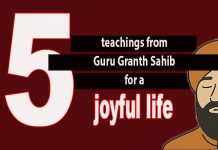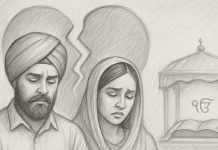
By Gurnam Singh | Opinion |
No matter how powerful, rich or intelligent one is, nobody can evade physical death. It is the most certain thing in life that, for most, is otherwise highly unpredictable. Nobody, really knows what will happen tomorrow, or the day after, but we all know we will die one day! And it is this inevitability of our ultimate demise, coupled with the unique human capacity to contemplate it, that motivates us to be curious about what happens when we die? This question, which is as ancient as humanity itself, sits at the intersection of science, spirituality and psychology. It is not merely a theological puzzle but a deeply human one, revealing our need to find meaning in the face of knowledge of our impermanence.
The Roots of Belief
A cursory scan of cultures, epochs and civilisations, reveals the ever presence of the idea that something of us endures beyond physical death. This universality itself is telling. From the pharaohs of Egypt entombed with possessions for their journey beyond, to the digital age where people now memorialise themselves on social media, to the idea that one day we might be able to download our minds into computers and ‘live for ever’, the instinct to survive death, both symbolically or spiritually, is hardwired into our species. For some, this conviction arises from faith. For others, it emerges from deeply personal experiences that seem to defy simple explanation.
Religious Frameworks
The world’s great religions have provided structured cosmologies to explain what awaits us beyond the grave.
In the Abrahamic traditions the soul is judged by a transcendent God, and its eternal destination depends upon moral conduct and divine grace. Heaven and Hell function as moral endpoints in a cosmic drama of justice.
In contrast, the Indic traditions speak not of finality but of cycles. The soul (ātman) transmigrates, reborn in different forms through saṃsāra, propelled by the moral calculus of karma. Liberation (moksha or nirvāṇa) represents an escape from this cycle — a merging into ultimate reality.
SEE ALSO: When I die
SEE ALSO: The Last Goodbye – Honouring The Creator’s Gift
Even among the non-religious, belief in some form of existence beyond death often stems from personal testimony. Near-Death Experiences (NDEs), for instance, feature in medical literature and spiritual discourse alike. Rational explanation would render such claims as anecdotal and unverified subjective experience. For those who live them, they are transformative and beyond doubt.
The Scientific Counterpoint
Science, grounded in materialism, maintains that consciousness is a function of the brain. When the brain ceases, so too does the mind. This view is supported by evidence that brain injury or disease can profoundly alter personality and awareness. Neuroscience proposes physiological explanations for NDEs in terms of surges of serotonin, oxygen deprivation, that that can induce euphoria and visions. Recent research even detects a final burst of neural activity moments before death. Yet a stubborn paradox remains. How do some individuals report clear, structured awareness and verifiable perceptions during periods of apparent brain inactivity? Science, for all its progress, has not yet fully explained consciousness itself, let alone its possible continuity.
The Role of Consciousness
Perhaps the most intriguing insight lies not in empirical data but in the nature of consciousness itself. The very ability to imagine life beyond death may be a defining feature of being human.
We are creatures capable of temporal transcendence. We can revisit the past, anticipate the future, and conceive realities beyond the present moment. This self-reflexive awareness — the “I” that observes the “me” — enables us to think of ourselves as distinct from the physical body. Without this mental separation, even the idea of immortality would be inconceivable.
This cognitive power, intertwined with emotion, gives rise to hope — arguably the most vital of human capacities. Hope allows us to endure uncertainty, to ascribe purpose to suffering, and to imagine continuity beyond dissolution. In this sense, belief in the afterlife may serve not merely a theological function but an evolutionary one: it transforms mortality from a void into a narrative of meaning.
The Sikh Insight
The Sikh perspective offers a subtle yet radical reinterpretation that is distinct from both the major faith traditions and science. It shifts focus from speculative metaphysics to the lived experience of consciousness and the here and now. Guru Nanak challenges us to understand that the real death is not the physical cessation of the body, but the death of ethical and spiritual awareness. To be “dead while alive,” is to be consumed by māyā and the illusion of materiality, ego, and separation from the Divine.
The Sikh path thus calls for an awakening of the mind, or what some call the soul. This is a form of liberation (mukti) that can only be attained through truthful living, ethical conduct, and the realisation of Oneness (Ik Oankar). The “afterlife”, therefore, becomes less a destination and more a dimension of awareness, or what is termed the Chauthā Pad (Fourth State) where individuality dissolves into universal consciousness. In this state of heightened awareness, the question “What happens when we die?” is becomes less important than “How do we live before we die?”
As Guru Nanak Dev Ji (SGGS, 9) proclaims, ਆਖਾ ਜੀਵਾ ਵਿਸਰੈ ਮਰਿ ਜਾਉ ॥ “Uttering the divine Name, I live; forgetting, I die.” In this profound formulation, death is not an ending but a metaphor for transformation — from ignorance to understanding, from separation to union. The real immortality lies not in endless continuation, but in realising the eternal within the temporal.
Conclusion
Science seeks evidence; spirituality seeks meaning. Yet both are animated by the same human impulse, that is the longing to know what, if anything, lies beyond our all too brief and insignificant period in a vast universe. Whether consciousness persists as a metaphysical essence or dissolves into the vast field of energy and matter, the dialogue between science and soul remains one of humanity’s most enduring frontiers.
Perhaps, as Guru Nanak suggests, the true wisdom lies in transcending the question itself and focussing on the here and now. And when we can train our minds to do this, then we start to realise that life is nothing more than a series of present moments, and the question ‘what happens when we die’ simply ceases to have any meaning.

Gurnam Singh is an academic activist dedicated to human rights, liberty, equality, social and environmental justice. He is an Associate Professor of Sociology at University of Warwick, UK. He can be contacted at Gurnam.singh.1@warwick.ac.uk
* This is the opinion of the writer and does not necessarily represent the views of Asia Samachar.
RELATED STORY:
There is no second coming (Asia Samachar, 15 July 2023)
ASIA SAMACHAR is an online newspaper for Sikhs / Punjabis in Southeast Asia and beyond. You can leave your comments at our website, Facebook, Twitter, and Instagram. We will delete comments we deem offensive or potentially libelous. You can reach us via WhatsApp +6017-335-1399 or email: asia.samachar@gmail.com. For obituary announcements, click here
































